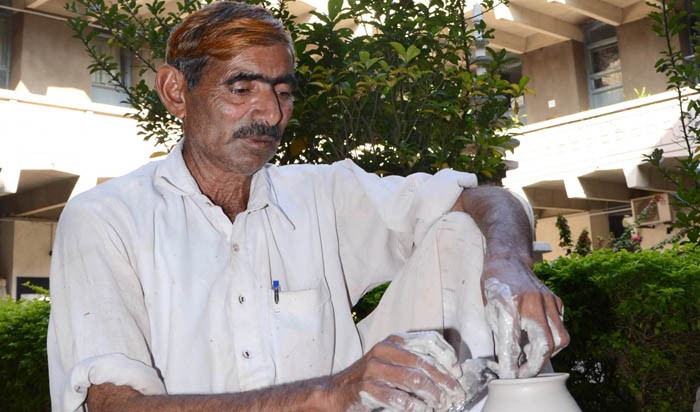

Muhammad Nawaz passed away on November 29 in Harappa. He was a potter who made replicas of artifacts from the archaeological site just outside the modern village, which is located west of Sahiwal in central Punjab.
"His finishing was better than mine, better than anyone’s," says Afshar Malik, an artist and professor at NCA who first met him in 1994.
"I remember seeing him with a collection of probably a hundred perfectly identical figurines that he had made by hand, and the grass was popping out in between them… It looked like it could have been an exhibition from MOMA [the Museum of Modern Art in New York]."
An average villager from Harappa, Nawaz was not educated or even literate. He met American archaeologist J.M. Kenoyer in 1986, and began working with him to create replicas of artifacts recovered from excavations at the Harappa site. His deep knowledge of the place and materials helped him not just recreate what had been made past, but it seemed, to bring the people of ancient Harappa back to life through his own work.
Sheherezade Alam, a ceramist who had been working with him for seven years, says: "I try to teach my students about heritage, but being from there and making the same kinds of pieces his ancestors made, Nawaz Bhai brought Harappa to life in a different way. I thought of him as the ‘Harappa man’."
Malik agrees. "There was an authenticity in his recreations. It seemed that he could think like the original Harappans. It’s like it was in his blood."
This unique skill made him an attraction at exhibitions of traditional crafts across Pakistan, such as at Lok Virsa in Islamabad and other venues in Lahore, Karachi, and Mansehra. He also demonstrated for archaeology students at Punjab University, Quaid-i-Azam University and Hazara University. In 1998, he travelled to the US, taking part in an exhibition on the Indus Civilisation at the University of Wisconsin.
Yet despite everything that this simple village man became exposed to, he was somehow able to stay true to his craft and to himself. According to Amna Shariff, another Lahore-based artist, he refused money for doing work that was not his own. When presented with designs for pottery pieces meant for someone’s residence in Lahore, he refused the commission, saying that his job was to create Harappan replicas.
He also brought clay from Harappa to artists for them to use, but charged only exactly what it cost him. Harappa has some of the best terra-cotta clay in Pakistan, which can be difficult to get.
From November 2 to 25, he was working with his son Allah Ditta at Quaid-i-Azam University in Islamabad, doing pottery demonstrations for students at the Taxila Institute for Asian Civilisations. On Monday November 25, he helped students fire their pottery in a replica of a Harappan kiln that he constructed there. After returning to Harappa, he suddenly fell ill and passed away on Friday night.
He is survived by his wife and seven children (five sons and two daughters), who still live in a basic house in the village of Harappa. Allah Ditta, who is only 16, plans to try to carry on his father’s work.
But perhaps there is more that can be done not just to remember him, but to continue what he struggled for. It could be as simple as improving the Harappa site museum, or even, setting up a small programme where people can train in the kind of work he did. Or it could mean increasing awareness about our heritage.
Many people in Pakistan do not know much about the Indus Valley Civilisation. It was the largest ancient urban civilisation in the world, yet its writing system is the only major ancient writing system still not deciphered. Most of the work done on Indus Valley has been done by foreigners.
Let’s try to change that; that might be the best tribute we can pay Muhammad Nawaz.